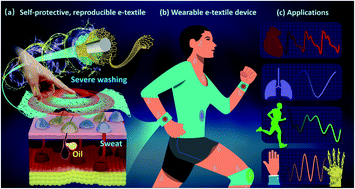A self-protective, reproducible textile sensor with high performance towards human–machine interactions†
Abstract
Textile-based electronic devices have aroused considerable interests due to their excellent flexible, wearable and breathable features towards the next-generation intelligent wearable human–machine interfaces. However, as they are vulnerable to the mechanochemical attacks from sweat, oil, etc. or wear and tear, the realization of functional electronic textiles (e-textiles) with simultaneous high performance, environment stability, and mechanical robustness still remains a big challenge. Herein, we designed a self-protective and reproducible e-textile (SPRET) composed of an entangled carbon nanotube (CNT) network, a combined polypyrrole-polydopamine-perfluorodecyltrlethoxysilane (PPy-PDA-PFDS) polymer layer and a textile substrate via a hierarchical construction strategy. The achieved SPRET sensor can protect itself from the interference of a variety of agents with superlyophobicity and reproduce after severe machine-washing or tape-peeling cycles with mechanical robustness. In our system, the resulted wearable e-textile could be effectively utilized to monitor human motions, realize intuitive human–machine interactions and robot-learning with sweat/water exposure, showing significant potentials in practical wearable e-textiles for continuous, long-term and reliable human behavior monitoring.



 Please wait while we load your content...
Please wait while we load your content...